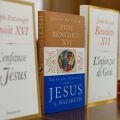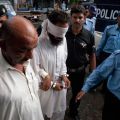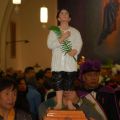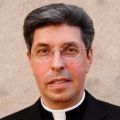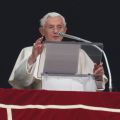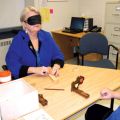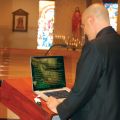NEWS
Catholics on both side of the Gaza border pray for hostilities to end
By Judith Sudilovsky, Catholic News ServiceJERUSALEM - As diplomatic efforts were underway to reach a ceasefire agreement between Hamas and Israel Nov. 20, Catholics on both sides of the Gaza border prayed for peace.
"When we pray for peace, we pray for peace for everyone," said Fr. Yoel Salvaterra, who serves the Hebrew-speaking Catholic community in Beersheba, after a morning in which more than 20 rockets landed in the city. "Our prayers have no borders. We know we are suffering here and they are suffering there. It is just suffering."
Egypt was reported to have been brokering a ceasefire agreement between Hamas and the Israeli government late Nov. 20, according to news reports.
The parish celebrated Mass Nov. 18 in the church bomb shelter, Salvaterra said, and only 15 people came to pray, about half the normal number. The community has about 150 members.
"People live in fear," he said. "Everybody is staying home. Sometimes they call me for assurance, sometimes I call them. The situation has not been easy as even before the Israeli operation we suffered from rockets once or twice a month. The uncertainty was difficult."
Though several homes in Beersheba took direct hits from the rockets, no one from the community has been injured, he said.
Going to Sunday Mass is a way of supporting one another and finding strength through prayer, said Rafoul Assy, 50, who hails from the northern all-Melkite village of Fassuta and has lived in Beersheba for more than 20 years. Although Assy was unable to attend Mass because of his work, he said his wife and four children found comfort in the familiar routine of the prayers.
"The Mass itself took only three-quarters of an hour but they stayed there for over an hour talking to the other people," said Assy. "It is difficult for the children. They spend their days in the bomb shelter. Every time there is a siren the little one grabs the iPad and runs to the shelter. They are afraid."
In Gaza, George Antone, 31, project manager for the Pontifical Mission for Palestine, told Catholic News Service Nov. 20 that people are staying home because it is too risky to leave. No one knows where Israel's bombs may land next, he said.
"The situation here is terrible. Last night it was as if we were living in hell. Every 15 minutes you could hear an explosion."
One member of Holy Family parish in Gaza died of a heart attack during a bombing and had just been buried at the church cemetery, he said. Otherwise, people leave their homes only to get essentials. Supplies such as fuel and bread are running low because flour can't be delivered to the bakeries, he said.
"I don't like the killing on either side. I respect life," Antone said. "This is not the way in which we can find a solution. Peace never comes with blood. That is what we say to the people in church. This will lead to nothing only a very bad scenario on both sides and the people will pay the price."
He added that he sees the conflict between Hamas and the Israeli government as not only political but also one stemming from religious fanaticism from both Muslims and Jews.
"We Christians are not political, we call for peace and to save lives," Antone said. "This conflict will lead to nothing. We pray a real truce will be reached and then afterward they have to start negotiating for peace. That is the only way to solve the problem. They have to sit and speak and find a way where there will be no war for our children and the coming generations."
In a Nov. 19 report Sami El-Yousef, regional director for the Catholic Near East Welfare Association's office in Jerusalem, noted widespread destruction in Gaza and said almost all of the Christian institutions have sustained some damage from the shelling in the form of broken glass and doors.
He said children and the elderly are paying the heaviest price and called for prayers that the hostilities would end as soon as possible.
Nativity story's significance continues to unfold today, Pope writes
By Carol Glatz and Francis X. Rocca, Catholic News ServiceVATICAN CITY - The Nativity story, like the whole story of Christ, is not merely an event in the past, but has unfolding significance for people today, with implications for such issues as the limits of political power and the purpose of human freedom, Pope Benedict writes in his third and final volume on the life and teachings of Jesus.
Jesus of Nazareth: The Infancy Narratives is only 132 pages long, yet it includes wide-ranging reflections on such matters as the significance of the virgin birth and the distinctive views of nature in ancient pagan and Judeo-Christian cultures.
The book was formally presented at the Vatican Nov. 20, and was scheduled for publication in English and eight other languages in 50 countries Nov. 21.
In the book, Pope Benedict examines Jesus' birth and childhood as recounted in the Gospels of Sts. Matthew and Luke. His interpretation of the biblical texts refers frequently to the work of other scholars and draws on a variety of academic fields, including linguistics, political science, art history and the history of science.
The book's publication completes the three-volume Jesus of Nazareth series, which also includes From the Baptism in the Jordan to the Transfiguration (2007) and Holy Week: From the Entrance into Jerusalem to the Resurrection (2011).
Jesuit Father Federico Lombardi, Vatican spokesman, said at the Nov. 20 book launch that the three books are the "fruit of a long inner journey" by Joseph Ratzinger, whose personal views they represent. While much of what the Pope says is accepted Catholic dogma, the texts themselves are not part of the Church's magisterium and their arguments are free to be disputed, Lombardi said.
In his new book, the Pope argues that Matthew and Luke, in their Gospel accounts, set out to "write history, real history that had actually happened, admittedly interpreted and understood in the context of the word of God."
The Pope calls the virgin birth and the Resurrection "cornerstones" of Christian faith, since they show God acting directly and decisively in the material world.
"These two moments are a scandal to the modern spirit," which expects and allows God to act only in ideas, thoughts and the spiritual world, not the material, he writes. Yet it is not illogical or irrational to suppose that God possesses creative powers and power over matter, otherwise "then He is simply not God."
Pope Benedict examines the political context of the time of Jesus' birth, which featured both the so-called "Pax Romana" — the widespread peace brought by the Roman ruler Caesar Augustus — and King Herod's thirst for power, which led to the slaughter of the innocents.
"Pax Christi is not necessarily opposed to Pax Augusti," he writes. "Yet the peace of Christ surpasses the peace of Augustus as heaven surpasses Earth."
The political realm has "its own sphere of competence and responsibility"; it oversteps those bounds when it "claims divine status and divine attributes" and makes promises it cannot deliver.
The other extreme comes with forms of religious persecution when rulers "tolerate no other kingdom but their own," he writes.
Any sign God announces "is given not for a specific political situation, but concerns the whole history of humanity," he writes.
The Pope writes that the Three Wise Men symbolize the purification of science, philosophy and rationality.
"They represent the inner dynamic of religion toward self-transcendence, which involves the search for truth, the search for the true God," the Pope writes.
The Pope also argues that the star of Bethlehem was a true celestial event. It "seems to be an established fact," he writes, that the conjunction of Jupiter and Saturn happened in 7-6 B.C., which "as we have seen is now thought likely to have been when Jesus was born."
A key topic in the book is the role of human freedom in God's divine plan for humanity.
"The only way (God) can redeem man, who was created free, is by means of a free 'yes' to His will," the Pope writes. It is precisely "the moment of free, humble yet magnanimous obedience," such as Mary and Joseph showed when listening to God, "in which the loftiest choice of human freedom is made."
Jesus, too, in His human freedom, understood He was bound to obedience to His heavenly Father, even at the cost of His earthly life.
The missing 12-year-old, rediscovered by an anxious Mary and Joseph in the Temple, was not there "as a rebel against His parents, but precisely as an obedient (son), acting out the same obedience that leads to the cross and the Resurrection," the Pope writes.
Pakistani High Court dismisses blasphemy charge against Christian girl
By Catholic News ServiceISLAMABAD, Pakistan (CNS) -- The Islamabad High Court ordered police to dismiss blasphemy charges against a Christian Pakistani girl whose arrest and detention drew international condemnation.
The ruling from Chief Justice Iqbal Hammeed ur Rehman Nov. 19 said there was no evidence that Rimsha Masih burned papers from the Quran, reported Pakistan's Dawn news agency.
"The court has quashed the case, declaring Rimsha innocent," Akmal Bhatti, the girl's attorney, told Agence France-Presse.
Rimsha was taken into police custody Aug. 18 after a resident of the area in which the girl and her family lived accused her of burning pages of the Islamic holy book. She was released on bail Sept. 8.
Two weeks after Rimsha was picked up, Khalid Jadoon Chishti, the imam or prayer leader who accused her of burning pages of the Quran, was taken into police custody. According to a police official quoted by the Associated Press, witnesses claim the imam tore pages from a Quran and planted them along with burned pieces of paper in the girl's bag.
He faces charges of planting evidence and desecrating the Quran used against the girl. The courts have yet to rule in the case.
Rimsha's parents said she is 11 years old and has Down syndrome; a court-appointed physician reported she was about 14 and is developmentally delayed.
Paul Bhatti, the only Christian member of Pakistan's federal cabinet, confirmed the high court had dismissed the case.
"I welcome this order. Justice has been done and the law of the land has been upheld by the court," he told Agence France-Presse.
"It will send out a positive image of Pakistan in the international community that there is justice for all and that society has risen up for justice and intolerance," he said.
Out of fear for their safety, Rimsha and her family moved to an undisclosed location after the girl's release.
Catholic relief workers praised by Muslim refugees in Indian camps
By Anto Akkara, Catholic News ServiceKOKRAJHAR, India (CNS) -- Besides her family, the most valuable things Majoni Bibi has these days are a few clothes, medicated mosquito nets, cooking utensils, water storage buckets and sleeping mats.
Bibi, a Muslim refugee forced with her family from their home as fighting erupted in July between tribal Bodos and Muslim settlers in Assam state, praised Catholic relief workers for the donations as her family continues to live in a camp for internally displaced people.
"We are very happy the Christians have helped in a big way. But for them, our life would have been miserable," said Bibi as she held her infant, who was born the camp at Basagaon.
Bibi is among hundreds of thousands of people displaced by months of ethnic clashes. She told Catholic News Service that had it not been for Catholic-run charities and the efforts of the Missionaries of Charity sisters, she and her family would have little.
"These sisters cared for us and (church workers) gave valuable and useful things," said Bibi, pointing to Sister Jacoba, superior of the Missionaries of Charity convent in nearby Bongaigaon.
Church workers have visited the camp and several others in the region, providing food and a variety of services and supplies.
The fighting has left more than 90 people dead and about 500,000 homeless in Kokrajhar region. More than 200,000 refugees -- the majority of them Muslims -- languish in 130 relief camps scattered across four districts.
Several Muslim refugees shared their appreciation for the workers' dedicated service in the camps in the Bodo heartland.
"The only people who came out to help us were the Christians," said Jahanara Begum, living in a riverbed camp in Basagaon.
Begum told the church workers that she had lost thousands of pounds of raw rice she had stocked in her home for sale when she, her husband and five children fled Dewalguri, a village attacked July 23.
"The church workers have shown real love for us and visited the camps regularly and attended to our people," Begum said.
Father David Napoleon, director of the Bongaigaon Diocese's social service program, said he has coordinated his work with Catholic Relief Services and Caritas India. More than two dozen emergency workers, including medical teams from St. Augustine Hospital in Bongaigaon joined the Missionaries of Charity sisters in visiting the camps.
"But it has not been easy. Nearly 15,000 Christians among the Bodos have also become homeless and some of our people have been strongly objecting to reaching out to the Muslim refugees," he said.
"But we told them that this was a humanitarian crisis and as true Christians, we have the duty to help all those in need," he added.
Harun Rashid Mondal, coordinator of a relief committee distributing rice and other food to refugee families, told CNS that "whatever may be the international talk of conflict between Muslims and Christians, here Christians are helping us like real brothers."
"The care and attention the Christians have shown to our people has helped change their attitude to the Christians. Real friends are those who help the people in need. The sisters have shown us what is real love," Mondal, a Muslim, said of the Missionaries of Charity who had helped bathe refugee children.
The anxiety of the Bodo community over Christians reaching out to Muslims was evident during a visit to Bodo relief camps in the town of Kokrajhar.
"My husband was stabbed (to death) and how can we can go back and live in the same place?" asked Korida Sanhala of Fakiragram village, who was at the Bodo camp.
"Sister, why do you still go to the camps of those (Muslim) people?" posed another Bodo woman to Missionaries of Charity Sister Leo Therese, even as men of the Bodo community rejected the plea of government officials to return the refugees to their village.
"They should not be helped," a young Bodo refugee woman reminded another nun when the church workers reached the Catholic relief camp at Kailo Mailo, more than 60 miles from Basagaon.
"Now our main focus is on youth-centered programs to deal positively with their trauma and anger and foster healthy interpersonal relationship," said Kaplianlal Thangluai, program officer for CRS in northeast India.
The program is facilitated by CRS-trained volunteers selected from among the refugees and residents of the host villages.
"We are also running a child-friendly space for children in the relief camps, as the children do not go to school," Thangluai added.
Celebrating a saint not much different than the faces in the pews
By Evan Boudreau, The Catholic RegisterTORONTO - Toronto's Filipino Catholics gathered Nov. 18 to honour one of their own who was last month elevated to sainthood.
About 1,300 people celebrated a Tagalog-language Mass at Our Lady of Assumption Church in honour of St. Pedro Calungsod of Cebu, a saint who shares many similarities with the people who sat in the pews thousands of kilometres from their homeland.
"We can identify with this young man because he came from a poor family and he became a migrant like all of us," said pastor Fr. Ben Ebcas. "The challenges during the time of St. Pedro are similar but different as well because the challenge is now in terms of the work opportunities, the job opportunities and the loneliness."
Ebcas continued by saying that financial stress, religious resistance in popular culture and Toronto's increasing diversity are challenges for the community.
"These are the challenges that sometimes rock our faith but if we have a person who we can draw inspiration from then we can say if (St. Pedro) was able to do it as a young man why not us because we were baptized in the same faith," he said. "It's very challenging to stand up for your faith in times of trials and tribulations and he's a great example for the young people."
Pope Benedict XVI canonized St. Pedro along with six others Oct. 21, including St. Kateri Tekakwitha.
Born in the Philippines in 1654, St. Pedro was chosen at age 14 as an exemplary young catechist to accompany the Spanish Jesuits in their mission to the Ladrones Islands, Philippines, later renamed the Mariana Islands. Inconsistent deliveries of provisions, harsh terrain and devastating typhoons made missionary life on the islands difficult to say the least — not to mention the loneliness from an absence of family which the immigrant parishioners can relate to.
But nature was not the only thing working against St. Pedro and the other missionaries. Influenced by rumours that missionaries had been using poisoned holy water for baptisms, local islanders resisted the Catholic influence. When word spread that the missionaries had performed a baptism on a village chief's child, he rose up against the missionaries and killed Calungsod. He was but 17 years old when he was martyred.
On March 5, 2000 Pope John Paul II beatified Calungsod who became the patron of Filipino youth, overseas Filipino workers and the archdiocese of Cebu, Philippines.
"The values that are worth emulating in the live of St. Pedro, as well the other saints, are still important values of today," said Ebcas. "The virtue of faith and hope and charity, they go beyond the bounds of time constraints."
While Ebcas said St. Pedro is a role model for all Catholics, it is seeing the youth engage with the new saint which really has him excited. Zanaida Yu, secretary for the archdiocese of Toronto's Filipino Catholic Mission, feels likewise. Yu, who organized the post-Mass reception at the parish hall, said the presence of the youth choir, who were organized just for the Mass, really touched her.
"It's a great feeling and very uplifting to see the young boys and girls, the youth, rendering a hymn for St. Pedro. That is very, very inspiring and a gift of God," she said. "We have been praying so hard for his canonization over the last 10 years. Now that he is a saint we have to propagate the devotion especially among the youth."
The parish plans to hold more events to celebrate St. Pedro's canonization.
Canadian priest appointed Holy See's head of protocol
By Deborah Gyapong, Canadian Catholic NewsOTTAWA, Ontario - Pope Benedict XVI has appointed Msgr. Jose Bettencourt, a native of Portugal who grew up in Ottawa, as the Holy See's head of protocol.
Msgr. Bettencourt is only the second non-Italian to hold the position. The post had been held by Msgr. Fortunatus Nwachukwa, a Nigerian diplomat, who was named Nov. 12 as apostolic nuncio to Nicaragua.
"We are very proud of him and the honor the Holy Father has conferred on him in calling him to this charge," Archbishop Terrence Prendergast of Ottawa said.
"He values his ties with his local church of Ottawa though his duties only permit a short stay at Christmas and a longer break over the summer months," the archbishop said. "He is invariably pleased to receive Canadians when I refer people to him and is kind to a fault."
In his position Msgr. Bettencourt is in charge of the protocol involving the Holy See's relationships with other states, from welcoming visiting heads of state at the airport to dealings with diplomats and ambassadors accredited to the Vatican.
His role includes overseeing how heads of state and others participate in ceremonies such as canonizations and consistories and ensuring that visitors to the Vatican are welcomed and relaxed.
Before his appointment, Msgr. Bettencourt worked closely in organizing papal audiences, briefing the pope and visiting bishops, heads of state and lay people for the visits.
He has served in the Vatican's Secretariat of State since 2002.
Born in 1962 in Velas, Azores, Portugal, Msgr. Bettencourt grew up in Ottawa, where he attended both elementary and secondary school. He graduated from the University of Ottawa before pursuing theological studies at Dominican College and St. Paul University, where he studied for the priesthood. He was ordained in 1993.
Health is universal good to be defended, not commoditized, says pope
By Carol Glatz, Catholic News ServiceVATICAN CITY - Good health is a benefit that needs to be defended and guaranteed for all people, not just for those who can afford it, Pope Benedict XVI told hundreds of health care workers.
The new evangelization is needed in the health field, especially during the current economic crisis "that is cutting resources for safeguarding health," he said Nov. 17, addressing participants at a conference sponsored by the Pontifical Council for Health Care Ministry.
Hospitals and other facilities "must rethink their particular role in order to avoid having health become a simple 'commodity,' subordinate to the laws of the market, and, therefore, a good reserved to a few, rather than a universal good to be guaranteed and defended," he said.
Nearly 600 people who work in the field of health care attended the council's Nov. 15-17 international conference, which focused on the theme: "The Hospital, Setting for Evangelization: A Human and Spiritual Mission."
The pope told them that, on the one hand, advancements in science and medicine have led to greater possibilities for curing the physical ailments of those who are ill.
"But on the other hand, it seems to have weakened the ability to care for the whole and unique person who suffers," he added.
Such advancements, the pope said, seem "to cloud the ethical horizons of medical science, which risks forgetting that its vocation is serving every person and the whole person, in its different phases of existence" from conception to its natural end.
It is important that the Christian concepts of "compassion, solidarity, sharing, self-denial, generosity and giving oneself" become part of the vocabulary of all people involved in the world of health care, he said.
"Only when the wellbeing of the person, in its most fragile and defenseless condition and in search of meaning in the unfathomable mystery of pain, is very clearly at the center of medical and assisted care" can the hospital be seen as a place where healing isn't a job, but a mission, the pope said.
Bringing life-giving and evangelizing assistance to others will always be expected of Catholic health workers, he said.
"Now more than ever our society needs 'good Samaritans' with a generous heart and arms open to all," he added.
Being Catholic brings with it a greater responsibility to society, and Catholics need to live their lives with courage as a true vocation, he said.
Professionals and volunteers working in health care represent "a unique vocation, which necessitates study, sensitivity and experience," he said. However, it's also necessary to go beyond academic qualifications and develop a true capacity to respond to the mystery of suffering and see one's work as a human and spiritual mission, he said.
Faith has a lot to teach about the mystery and value -- or "science" -- of suffering, and Catholic health workers "are qualified experts" in this field, the pope said.
"Your being Catholic, without fear, gives you a greater responsibility in the realm of society and the church," Pope Benedict said. "It's a real vocation" that was lived in an exemplary way by many saints including St. Gianna Beretta Molla and servant of God Jerome Lejeune, the French Catholic geneticist.
Social conservatives need a more positive spin on message
By Deborah Gyapong, Canadian Catholic NewsOTTAWA - Social conservatives, often blamed for election defeats like that of U.S. Republican Mitt Romney in the Nov. 6 American election, need to find better ways to stress the positives of their message if they want that to change, say members of a Canadian think tank.
“Statistics are on the side of social conservatives when we look at the outcomes for our children, for moms and dads, for families, and the negative consequences of abortion,” said Institute of Marriage and Family Canada (IMFC) executive director Dave Quist.
But getting the message out is daunting in a climate where “the left has been way out in front” and most people do not engage in elections until the last weeks or days, he said.
As Republicans in the United States are analysing their election defeat, many pundits blame the social conservatives in the party for the loss. Media reports on gaffes made by several Republicans on abortion were plastered across headlines across the United States, and many believe helped President Barack Obama to his second-term as president.
It is no secret that most social conservatives are pro-life, and these views are deemed a liability in Canada. Quist noted abortion has been perceived by Prime Minister Stephen Harper as the “third rail” of Canadian politics ever since Stockwell Day’s 2000 campaign where the openly Christian Day was painted as “scary” and ridiculed for his pro-life, creationist and evangelical beliefs.
Yet Quist pointed out “the abortion discussion is alive and well and perhaps thriving in many parts of the country.”
But Andrea Mrozek, IMFC research and communications director, said social conservative principles are about much more than abortion or opposition to same-sex marriage, though they have been “branded” that way. It is about the strength of civil society, promoting the common good and caring for families, the elderly and the vulnerable.
Mrozek predicted social conservative principles will become popular when Western social democracies, especially the United States and its $16-trillion debt and its yearly trillion-dollar deficits, hit the fiscal cliff “and government can’t fund programs any more and suddenly we have to get our act together.”
“When we contracted everything out to the government we did change our personal way of thinking that personal charity does not need to be done; somebody else takes care of that for me,” she said. “I’m alarmed by what I walk by on the street sometimes, that I think, well, someone else is going to take care of it.”
Social conservatives are used to supporting charities, such as crisis pregnancy centres, that receive no government dollars, she said. This kind of charitable impulse will be needed when government programs cannot be maintained, she said.
“If it crashed we’ll have a whole different conversation. People will either sink or swim and won’t have anybody to rescue them, except people who are prepared to reach out.”
IMFC communications strategist Eloise Cataudella, a Catholic from Toronto, spoke of the transformative nature of personal charity, both for the giver and the receiver. There’s a difference between the government’s social safety net and the giving of time and resources of a small charitable organization. Those who receive government help because they are unable to get a job might say “the government is taking care of me because they have been mandated to do so,” she said.
“This does not inspire the sense that the government cares for me as an individual,” she said. “A small organization, struggling to make ends meet, offers a sense of love behind that charity that is transformative and helps lift people out of poverty.”
Many are now “caught or stuck in a safety net,” she said.
While abortion remains one of the top issues identified with social conservatism, Harper has been able to “remain above the fray” as backbenchers in his caucus use private member’s business and other means to keep the abortion debate alive, Mrozek observed.
Harper’s strategy to push social conservatives aside “is one of the worst I’ve ever seen,” and “backfiring,” she said.
“These social conservative issues keep popping up and (Harper) has no way of dealing with it other than to say ‘stop’ or to use the resources of the PMO (Prime Minister’s Office)” to get Tory caucus members to vote against various Conservative private member’s bills or motions, such as MP Stephen Woodworth’s Motion 312 that would have investigated the personhood of the unborn child, she said.
Toys for the classroom foster communication skills
By Evan Boudreau, The Catholic RegisterThe Dufferin-Peel Catholic District School Board is using toys in a pilot project aimed at increasing communication skills between students.
The suburban board to the west of Toronto has partnered with Twenty One Toys to introduce its innovative Connexions puzzle packages into the classroom.
Founded by Montrealer Ilana Ben-Ari, the toy company aims to prepare future employees for the job market by teaching them the importance of creativity, collaboration and innovation when problem solving. The Connexions puzzle challenges two participants to configure 10 different three dimensional shapes into the same pattern without the use of their eyes. The aim is to strengthen communication skills.
“It’s an opportunity to work together with fun or play at the centre (but) really with the focus on deepening our understanding of how we work together,” said Shirley Kendrick, the board’s superintendent of special education and support services.
“From a Catholic perspective one of the things that was intriguing to us was the whole concept of honouring the dignity of all students.”
According to Kendrick, the board’s director of education and associate director responsible for instructional services — John Kostoff and Ralph Borrelli respectively — challenged staff this year to look at 21st century learning for all. This led Kendrick and assistant superintendent Les Storey to Twenty One Toys.
“One of our brilliant and leading academic consultants, Stephen Hurley, introduced the concept to me … and that’s how we met Ilana,” said Kendrick. “The artist and designer looked from an industry perspective and she was given a grant to look at supporting students who were nonsighted and trying to get them to work with their sighted peers.”
Of course communicating this way can be frustrating, said Storey, especially for sighted peopled. But that’s part of the learning process.
“It’s also a chance when we do it in schools for kids to reflect on identifying when they got frustrated (and) what’s making you frustrated,” said Storey. “It’s not just about special ed students. This is a chance to level the playing field for everybody. It gives everyone an equal opportunity to be part of the conversation and discussion.”
Staff are presenting the products to schools and gauging the program’s effectiveness as well as ways of introducing it into the classroom. Those participating in the pilot project include teachers, youth workers, dictional resource workers and support staff.
“We’re very excited to hear the feedback from the field,” said Kendrick. “We’re excited to hear how did people use them and to hear the narrative or the stories that come back to us to say, we started with this and it’s grown into something that perhaps we didn’t expect.”
While details about how exactly these toy packages will be introduced, and used, is still to be worked out, the intention is already clear.
“We think about the application of these toys or other supports as a way of saying … the types of supports that some students need really can be good types of support for all,” said Kendrick. “We all need to learn to see what others are feeling.”
Crossing the digital divide
By Evan Boudreau, The Catholic RegisterTORONTO - Fr. Tom Gibbons believes the Catholic Church needs to strengthen its presence in the digital realm of parish life today to connect with the Catholics of tomorrow.
“I constantly have people coming up to me saying the Catholic Church doesn’t seem to talk to me any more. Technology has a role to bridge that gap,” said Gibbons, the associate pastor at Toronto’s St. Peter’s parish. “That being said we also have to be careful that the Mass doesn’t turn into a video game and that we’re worshipping God and not worshipping Google.”
As a former web developer for the U.S. bishops’ Catholic Relief Services, and one of the archdiocese of Toronto’s newest priests, having been ordained in May, Gibbons admits he’s likely more open to technology than the majority of his colleagues.
“With any technology I fall somewhere in between the spirit of Steve Jobs, where it is let’s keep on pushing the boundaries, and Jurassic Park where just because you can do something doesn’t mean that you should,” he said. “There’s wisdom in navigating between those two, not always necessarily picking the one in the middle.”
What intrigues him is new technology’s potential to educate parishioners on what’s happening during the Mass — something he believes many in the pews don’t understand any more, causing them to feel disconnected.
“There’s no reason that there couldn’t be some (digital) interactive options before and after the Mass,” he said. “I do think that we could be more open to technology than we are, even in the liturgy.”
For this further integration to be successful, both in connecting with contemporary and future Catholics as well as preserving tradition, the conversation needs to start soon, said Gibbons. And that conversation must involve priests, bishops, theologians, academics and parishioners — especially those who feel disconnected from the current language of the Church.
While Gibbons said money keeps him from gently pushing the traditional boundaries by exploring the further integration of technology in the Mass, at least one priest in the archdiocese has overcome the financial hurdle.
When Fr. Mario Salvadori’s parish, St. Joseph the Worker in Thornhill, Ont., underwent a $1.3-million renovation, the businessman-turned-priest had the parish outfitted with a large screen on either side of the altar, a projector and a computer-friendly pulpit so he could reinforce the message of his homilies with digital media.
“If you are going to go beyond the traditional six-minute homily, you can’t keep their attention just verbally, you have to show them something,” said Salvadori. “The video puts an additional value into the message. The video helps to make another link that otherwise wouldn’t have been made.”
Although Salvadori’s willingness to integrate technology into the liturgy differs from that of Gibbons, both priests were able to agree that the Church needs to start speaking the language of the future — digital language.
“I don’t think you’re ever going to get someone with a tablet in the pews,” said Salvadori. “It’s about us as a Church better using technology to evangelize.”
Gibbons cites one factor in particular behind the Church’s deliberate pace — tradition.
“As a Catholic Church we tend to err on the side of tradition,” he said. “We ground our faith in tradition. Advances in technology tend to be a break in tradition.”
Neil McCarthy, director of communications for the archdiocese of Toronto, Ontario’s most digital diocese, understands this.
“Our approach is not to rush things, rather, to do it right than do it quickly,” said MacCarthy. “We are grounded in prayer and that can never be replaced by technology.”
While this sense of traditional stability is what Gibbons said attracted people to the Church in the past, it can create a barrier for younger Catholics who may feel out of touch with traditional methods to celebrate their faith.
“One of the knocks on the Catholic Church is that it’s so busy looking backwards that it forgets to look forward,” said Gibbons. “There are some ways in which I think religion should, needs, to bend to culture.”
It is happening slowly however. Many priests in the Greater Toronto Area are utilizing social media and uploading recordings of their homilies online, while many parishes have developed web sites. And MacCarthy said online fundraising shows great potential for an archdiocese the covers about 13,000 square kilometres, though it isn’t going to fully replace traditional forms of donating.
Toronto refugee conference to take the next step forward
By Michael Swan, The Catholic RegisterTORONTO - Three years ago Catholic commitment to refugees took a major step forward with a national conference of Catholic refugee offices. It’s time to take another step forward, Office for Refugees Archdiocese of Toronto director Martin Mark said.
ORAT will host a four-day national gathering of refugee ministries at the Toronto Crowne Plaza Airport Hotel Dec. 3 to 6. Mark predicts more than double the 70 delegates to the last refugee conference in 2010 will attend “With One Voice — We Are the Hope.”
While three years ago the focus was on organizing parishes to help Iraqi refugees, many of them Christian, this time around the refugee ministries will be finding ways to defend the civic sponsorship program as the federal government constantly adjusts its regulations and procedures for sponsoring refugees.
Recently Citizenship and Immigration Canada issued new forms that recognized refugees are expected to fill out if they wish to come to Canada. The guide for how to fill out the forms runs over 50 pages, said Mark. The Canadian government is also making its refugee forms available only over the Internet.
Not many people in refugee camps have access to the Internet and the traumatized and desperate may find a form with a 50-page guide daunting, Mark said.
The history of Catholic sponsorship of refugees has been through emotional waves of boom and bust, beginning with an outpouring of parish-based generosity more than 30 years ago when the plight of Vietnamese boat people inspired Canada’s civic refugee sponsorship system. As the boats faded from the south Pacific seas, Catholic sponsorship waned. The crisis in Iraq which sent two million refugees into Syria, Lebanon, Turkey, Jordan and elsewhere revived Catholic interest in sponsorship in 2006.
With the upcoming conference, Mark hopes to ensure the sustainability of a national network of Catholic sponsorship agencies.
While there is still a major problem of unsettled Iraqi refugees, more than half the world’s 42 million refugees are in Africa and there are many opportunities for parishes to contribute to solutions — and not all of them will tax a parish’s budget, Mark said.
There are 600 refugees in Ghana, in a UNHCR camp outside of the capital Accra. With a concerted effort, Canadian Catholic refugee sponsors could close that camp, said Mark.
The conference will begin with Mass celebrated with Cardinal Thomas Collins.
To participate in the conference, call Patricia Cross at (905) 889-5724 or e-mail her at pcpat@rogers.com.


